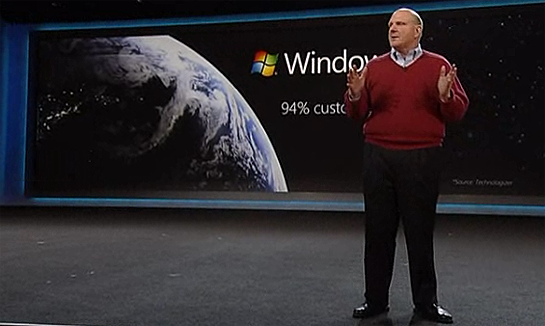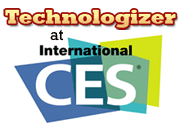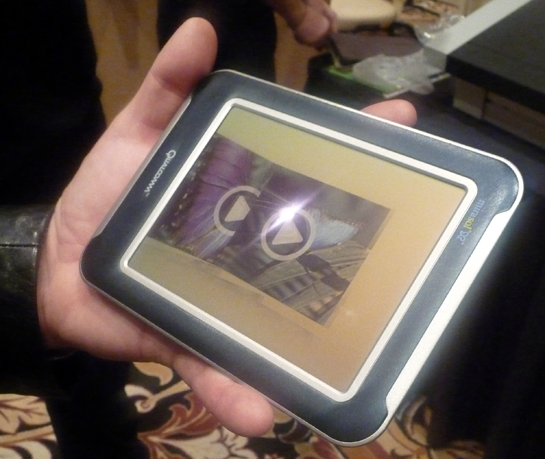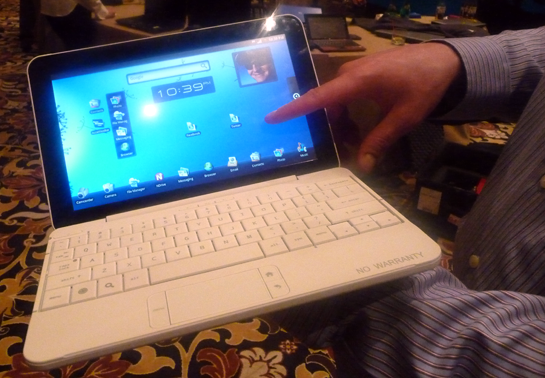At Steve Ballmer’s Wednesday night CES keynote, he quotes our Windows 7 satisfaction survey as evidence of Windows 7’s strong start. (He merely called it “a recent survey,” but note the attribution in tiny type at the lower right-hand corner…)

At Steve Ballmer’s Wednesday night CES keynote, he quotes our Windows 7 satisfaction survey as evidence of Windows 7’s strong start. (He merely called it “a recent survey,” but note the attribution in tiny type at the lower right-hand corner…)

I’ve craved an external keyboard for my iPhone for awhile now, but assumed that the phone lacked the technical hooks third-party manufacturers needed to make a keyboard talk to it. Here, however, is the first iPhone keyboard I’ve seen. It’s not the folding Think Outside-style model I’ve been envisioning, but I’m going to try and check it out here at CES.
 Earlier today, I lounged in the passenger seat while a Ford employee sat behind the wheel and showed me MyFord Touch–the upcoming radically upgraded version of the digital entertainment/information platform that the company began offering a couple of years ago as Ford Sync. The new version has a speedometer that’s flanked by two LCDs, and a jumbo color touchscreen, and it lets you do a gazillion things–from listening to music to getting directions to adjusting mood lighting in the car to turning your auto into a mobile hotspot. I loved it. And the chances of the Ford rep getting distracted and causing an accident were…well, nil, because we were sitting in a fake car interior inside a conference room in the Las Vegas Convention Center here at CES.
Earlier today, I lounged in the passenger seat while a Ford employee sat behind the wheel and showed me MyFord Touch–the upcoming radically upgraded version of the digital entertainment/information platform that the company began offering a couple of years ago as Ford Sync. The new version has a speedometer that’s flanked by two LCDs, and a jumbo color touchscreen, and it lets you do a gazillion things–from listening to music to getting directions to adjusting mood lighting in the car to turning your auto into a mobile hotspot. I loved it. And the chances of the Ford rep getting distracted and causing an accident were…well, nil, because we were sitting in a fake car interior inside a conference room in the Las Vegas Convention Center here at CES.


I’m impressed by MyFord Touch, which will start to appear in cars later this year–price TBA–and which Ford plans to roll out to eighty percent of its line within five years. It–and/or stuff like it–will be a factor the next time I plunk down money for an automobile. But this New York Times story reports on concerns that the new generation of Internet-connected car computing systems simply demands too much attention from drivers. One of the naysayers is U.S. Secretary of Transportation Ray LaHood, who’s presumably in a position to do something about them if he so chooses.
Your opinion, please.
 With the Game Room, Microsoft’s hoping to capture the old magic of video game arcades, minus the stale air, sugar highs and wasted quarters.
With the Game Room, Microsoft’s hoping to capture the old magic of video game arcades, minus the stale air, sugar highs and wasted quarters.
I got some questions answered on service, which will be available on Windows and Xbox Live this spring. Here are the important details (if you’re a retro game nerd):
-30 games will be available at launch, including Centipede, Lunar Lander and Night Driver (full list here), from arcade systems as well as the Atari 2600 and Intellivision. Microsoft says it’ll release 7 new games per week after launch.
-Games cost $3 each for either Xbox Live or Windows, and $5 if you want the luxury of playing on both. The arcade itself is open to any level of Xbox Live (no Gold subscription necessary).
-Unlike some of the classic games Microsoft released earlier this year, these are straight emulators with no boosts in resolution or graphics. Unfortunately, that means if there’s any overlap, you’ll have to pay for the Game Room titles again.
-Players build their own virtual arcades, with cabinets that mimic the hulking monstrosities of yesteryear. As your arcade grows, you get new rooms or entire new floors that can be decorated differently. But you don’t navigate these with an avatar — the camera simply slides between each room and cabinet.
-Other players can visit your arcade, and they’ll earn free play tokens based on how many games you have. They can also demo any game once, or can pay 40 Xbox Live points (50 cents) for extra plays.
-Downer: You can’t directly play against another player online (so no head-to-head in Combat). Instead, online multiplayer consists of high score or other challenges you send to your friends. Two-player games will work locally.
The service seems promising, and I particularly like all the ways Microsoft will give players to try games. It’s like we’re getting allowance all over again.
At last year’s CES, Palm stole the show with the introduction of the Pre–one of the most spellbinding demos I’ve ever seen that didn’t involve Steve Jobs. No repeat this year, but the company did have a press conference at which it announced the Pre Plus (with some improvements to the keyboard, navigation, and build quality, plus a Touchstone-compatible inductive-charging back cover as standard equipment) and the Pixi Plus (with Wi-Fi).
Maybe the best news about these models: They’re on Verizon Wireless. Exclusively, Palm says–starting January 25th.
Here at CES, I just visited with the folks behind Swype, the touchscreen input technology that knocked my socks off in canned demos I’ve seen, and which recently shipped on its first phone, Samsung’s Omnia II. I finally got some hands-on experience, and…I’m not only impressed, I’m more impressed than before, because the learning curve is small and the accuracy is remarkable.
Watching it in action remains the best way to understand it:
The only thing I don’t like about Swype: The company’s strategy is to get it built into as many phones (and tablets, and other devices that need a touch keboard) as possible. So they’re not selling it as a stand-alone app. If by some miracle this technology were to become available on the iPhone, it would be a great day indeed.
 Unlike Plastic Logic, new e-reader arrival Skiff isn’t showing off its stuff on the show floor. But it’s demonstrating its reader–which it’s only saying will arrive sometime in 2010, at an unspecified price–in a private room. I got a sneak peek, and came away intrigued.
Unlike Plastic Logic, new e-reader arrival Skiff isn’t showing off its stuff on the show floor. But it’s demonstrating its reader–which it’s only saying will arrive sometime in 2010, at an unspecified price–in a private room. I got a sneak peek, and came away intrigued.
Physically, the Skiff reader looks a lot like Plastic Logic’s Que–it has a magazine-sized screen, a touch interface, and a thin case. Both readers use their extra real estate and resolution to render pages with more style and fidelity than is afforded by the smaller screens on the Kindle and Nook. But while Plastic Logic is pitching the Que as a business tool, Skiff is focusing on making magazines and newspapers easy to get and read. The demo I got involved digital versions of the Wall Street Journal and Esquire that maintained a newspaper and magazine-like feel, respectively, along with the typography, art, and layouts you associate with those two publications. They’re not exact replicas of the print incarnations, though–they’re scaled to the available screen space on the Skiff. And the ads provide some interactivity, such as a car one that lets you find a local dealer.
 Plastic Logic has been teasing us with previews of its e-reader–now dubbed the Que proReader–for sixteen months. This morning at CES, it formally announced the product on the show floor, complete with demos of the final version and full details on features, pricing, and availability.
Plastic Logic has been teasing us with previews of its e-reader–now dubbed the Que proReader–for sixteen months. This morning at CES, it formally announced the product on the show floor, complete with demos of the final version and full details on features, pricing, and availability.
As Plastic Logic has said all along, the Que is based on its proprietary plastic transistor technology (which allows for a large, lightweight, glass-free display), has a screen the size of an 8.5″-by-11″ piece of paper, uses a touchscreen interface, and is aimed at businessfolk who “need to read” rather than those who read for pleasure. It’s signed content deals with business-oriented media brands such as the Wall Street Journal, Forbes, and Fast Company (and my old employer IDG), it lets you drag and drop Microsoft Office documents and other business files from your PC to the e-reader, and it has extensive tools for annotating and organizing documents. It also lets you view your Exchange calendar and has a complementary BlackBerry app which lets you transfer files to the Que.
 It’s still early here at the Consumer Electronics Show–the halls bursting at the seams with exhibitors open later this morning for the first time. But if someone asked me what the most interesting thing is that I’ve seen so far, the answer’s easy: It’s the low-power color displays for e-readers and other gadgets from Qualcomm’s Mirasol division, which the company was showing off at the Digital Experience event Wednesday night.
It’s still early here at the Consumer Electronics Show–the halls bursting at the seams with exhibitors open later this morning for the first time. But if someone asked me what the most interesting thing is that I’ve seen so far, the answer’s easy: It’s the low-power color displays for e-readers and other gadgets from Qualcomm’s Mirasol division, which the company was showing off at the Digital Experience event Wednesday night.
Mirasol’s technology produces screens that look a lot like the E-Ink ones found on nearly every e-reader to date–they’re unilluminated and therefore look better in bright light than in dim environments. But Mirasol’s displays, unlike E-Ink, do color and have decent refresh rates. If the shipping version of the display technology’s as impressive as the demo, that means that it’ll allow for e-readers with color pages, video, and slicker user interfaces. Here’s a photo of a concept device that doesn’t do the technology justice.

The Mirasol technology, which involves tiny mirrors creating colors by refracting light, doesn’t have anything to do with how E-Ink works, but it shares some of the virtues that make it a good candidate for e-reading devices, including extremely low power consumption. (Like E-Ink, it only draws power when the page is being changed, not when an image is static.) Actually, a Mirasol representative told me that it uses far less power than even E-Ink.
The tech demo at Digital Experience knocked my socks off, but Mirasol isn’t quite ready to go into consumer products yet. Qualcomm says to expect an e-reader incorporating the the technology by the third quarter of the year.
 Spotted Wednesday evening at Digital Experience, an unofficial press event here in Las Vegas during CES week: an HP netbook with Google’s Android OS, a touchscreen, and a Qualcomm Snapdragon processor. It bears a familial resemblance to HP’s Mini netbooks, but has been rethought in multiple ways–for instance, it lacks the row of function keys that’s standard equipment on all Windows PCs and Macs.
Spotted Wednesday evening at Digital Experience, an unofficial press event here in Las Vegas during CES week: an HP netbook with Google’s Android OS, a touchscreen, and a Qualcomm Snapdragon processor. It bears a familial resemblance to HP’s Mini netbooks, but has been rethought in multiple ways–for instance, it lacks the row of function keys that’s standard equipment on all Windows PCs and Macs.

This machine’s presence at the show isn’t nearly the big deal it might be, for one simple reason: HP says it’s just experimenting with Android. This is a concept PC, and there’s no news about its chances of turning into a shipping product you can buy. Still, you gotta figure that if HP has gone through the bother of building this prototype, there’s a real chance it’ll commercialize it in 2010. Unless, that is, it decides to scrap the Android OS and begin over again with Google’s Chrome OS…
